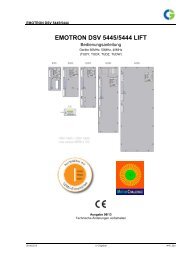Emotron FDU 2.0 Variable Speed Drive
Emotron FDU 2.0 Variable Speed Drive
Emotron FDU 2.0 Variable Speed Drive
You also want an ePaper? Increase the reach of your titles
YUMPU automatically turns print PDFs into web optimized ePapers that Google loves.
7.5 Load Monitor and Process<br />
Protection [400]<br />
7.5.1 Load Monitor [410]<br />
The monitor functions enable the VSD to be used as a load<br />
monitor. Load monitors are used to protect machines and<br />
processes against mechanical overload and underload, such<br />
as a conveyer belt or screw conveyer jamming, belt failure on<br />
a fan or a pump dry running. The load is measured in the<br />
VSD by the calculated motor shaft torque. There is an overload<br />
alarm (Max Alarm and Max Pre-Alarm) and an underload<br />
alarm (Min Alarm and Min Pre-Alarm).<br />
The Basic Monitor type uses fixed levels for overload and<br />
underload (pre-)alarms over the whole speed range. This<br />
function can be used in constant load applications where the<br />
torque is not dependent on the speed, e.g. conveyor belt,<br />
displacement pump, screw pump, etc.<br />
For applications with a torque that is dependent on the<br />
speed, the Load Curve monitor type is preferred. By measuring<br />
the actual load curve of the process, characteristically<br />
over the range of minimum speed to maximum speed, an<br />
accurate protection at any speed can be established.<br />
The max and min alarm can be set for a trip condition. The<br />
pre-alarms act as a warning condition. All the alarms can be<br />
monitored on the digital or relay outputs.<br />
The autoset function automatically sets the 4 alarm levels<br />
whilst running: maximum alarm, maximum pre-alarm, minimum<br />
alarm and minimum pre-alarm.<br />
Fig. 44 gives an example of the monitor functions for constant<br />
torque applications<br />
38 Main Features <strong>Emotron</strong> AB 01-4428-01r2

















